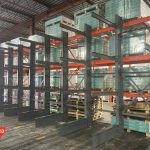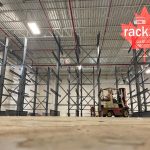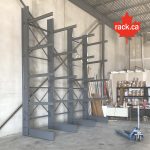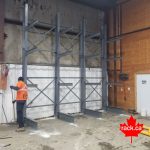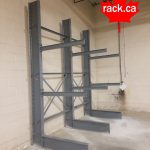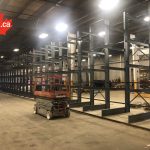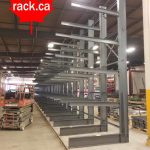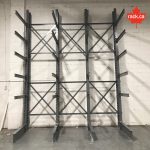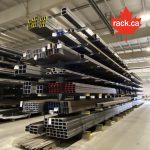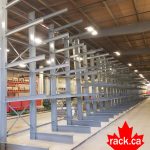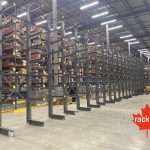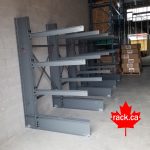Cantilever racks are used in warehouses and distribution centers to store bulky, lengthy, or oddly shaped objects such as steel beams, lumber, piping, corner beads, drywall, and similar building materials. The exterior of the cantilever racking systems lack vertical supports to prevent obstructions and facilitate easy access to the building materials that are being stored.
There are four major components that all cantilever racking systems must have:
- Uprights, which can be single- or double-sided depending on the type of load being stored
- Straight or inclined arms of varying lengths to hold the inventory in place and prevent it from falling off of the unit
- Brace sets, which are used to secure the entire cantilever racking system in place and add stability
- A base
Cantilever racking systems are incredibly versatile and can be custom-fitted into practically any warehouse facility. They offer maximum vertical and horizontal storage capacity optimization by simply adjusting the height of the shelves and ascertaining that there’s enough clearance space on top or moving the storage arms to make more room.
Types of Cantilever Racks
There are two main types of cantilever racking systems that are frequently used in industrial work environments.
- Roll-formed cantilever racks are lightweight and are bolted to the ground with anchors. Their main disadvantage is structural steel is more rigid and a heavier duty metal that can hold larger capacities with less chance of damage. Roll form is made with sheet metal formed into its shape (part of the reason it is less damage resistant).
- Structural cantilever racks are used for more heavyweight storage applications and therefore need to be bolted to the ground to prevent them from rolling. These racks are composed of hot-rolled c-channel structural steel. Because they have a weight capacity of over 1,500 lbs, structural cantilever racks are the preferred choice for many industrial facilities that have large volumes of heavy materials to store or move.
How to Properly Install Cantilever Racking Systems
When it comes to installing custom-designed cantilever racking systems for your facility, it’s important to follow the manufacturer’s instructions and recommendations very closely. Adhere to all safety standards and read the instruction manual carefully before beginning the installation process. Most important, ensure that all storage rack assembly is performed only by qualified personnel who are experienced and knowledgeable regarding local safety standards and regulations.
Read the Assembly Instructions
Manufacturers of cantilever racking systems always provide detailed installation instructions that outline safety standards, regulations, and precautions that should be taken during the process. They also recommend that installation is only performed by qualified personnel to prevent on-the-job injuries or fatalities. It’s important to read the instructions carefully and follow them step-by-step to guarantee that the installation is done right.
Double Check That You Have Everything You Need
Instruction manuals include a list of all of the materials and components that are required to install cantilever racking systems. While most of the pieces and hardware are provided by the manufacturer, certain necessities such as tools or minor components might not be included. Tape measures and outlining chalk are among the most commonly used tools you should have on hand.
Take stock of all of the tools and components you’re going to need for the installation to make sure that nothing is missing. If a piece that was supposed to be provided by the manufacturer is missing or damaged, you can contact them directly to send you a replacement.
Prepare the Space
Clean up the space where the cantilever racking system will be installed. Remove obstructions and potential hazardous materials to eliminate the risk of injury or damages.
Determine the Rack Configuration
Measure the dimensions of the aisle or space where the rack will be located to determine the most optimal setup and positioning of the completed rack. Draw a true-to-form and accurate chalk outline to use as a reference point throughout the installation.
Inspect the Components
Before commencing the installation process, check that all of the components are in proper working condition. Look for scratches, dents, and signs of abrasion or rust that could hinder the performance of each piece or throw the entire cantilever racking system off balance.
Assemble the Bays One at a Time
Using the instruction manual and diagrams provided by the manufacturer, assemble each bay one at a time. Start by laying out the components of each bay on the floor to see how they all fit together. You should have two columns, bases, and the correct number of arms that are required.
Install Additional Bays as Needed
Depending on how much storage space you need and the dimensions of the cantilever racking system, you may need to assemble and install additional bays to complete the structure and support the starter bays.
Install Shelves or Decking
Custom shelving and decking can be added to your cantilever racking system if additional support is required for various load sizes and weights.
Install the Bracing and Anchors
Bracing and anchoring are required to stabilize cantilever racking systems. To maximize stability, brace sets are bolted in between two uprights and anchors are bolted to the ground the secure the structure in place.
Where to Purchase High-Quality Cantilever Racks in Toronto
Canadian Rack Technologies Inc. is one of the leading providers of high-quality and expertly engineered custom cantilever racking systems in North America. We stock a variety of regular-duty and structural cantilever racking systems that are ready to be shipped out quickly. Contact us today to get a quote.
